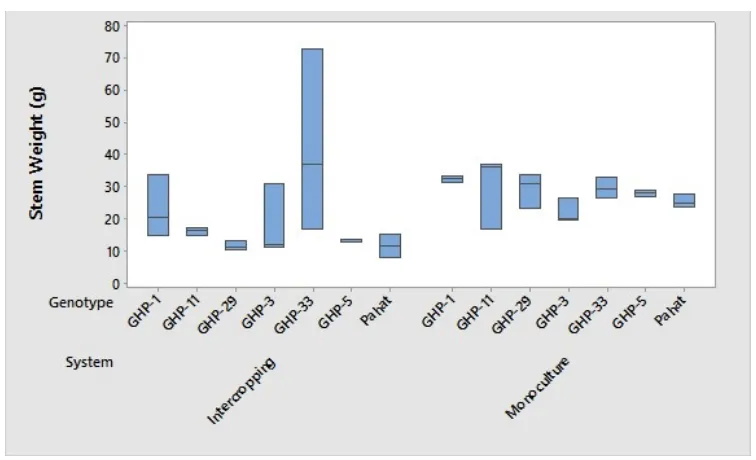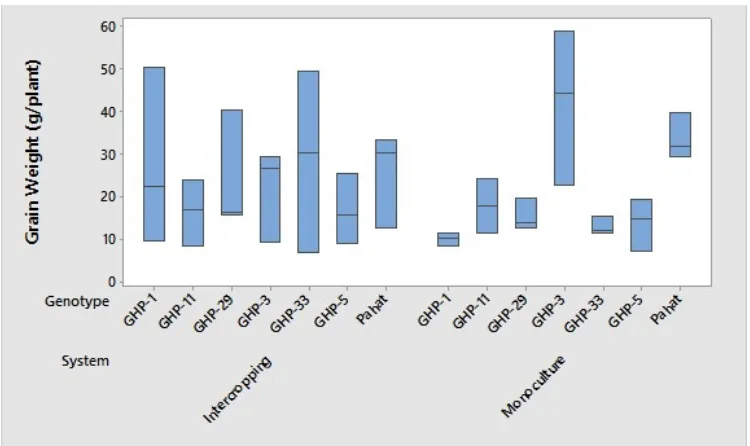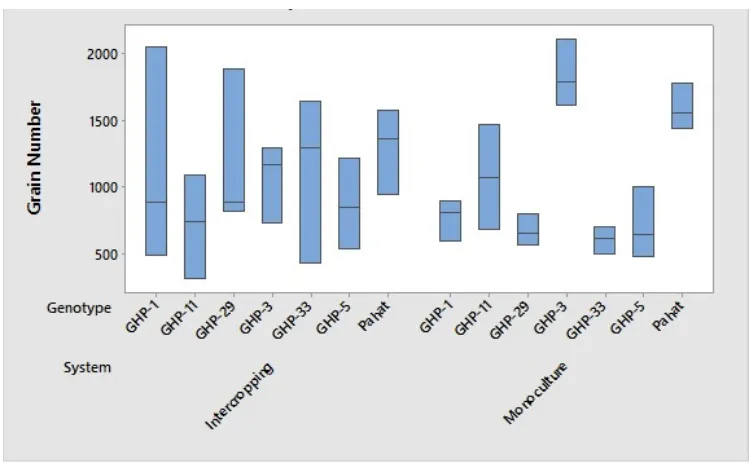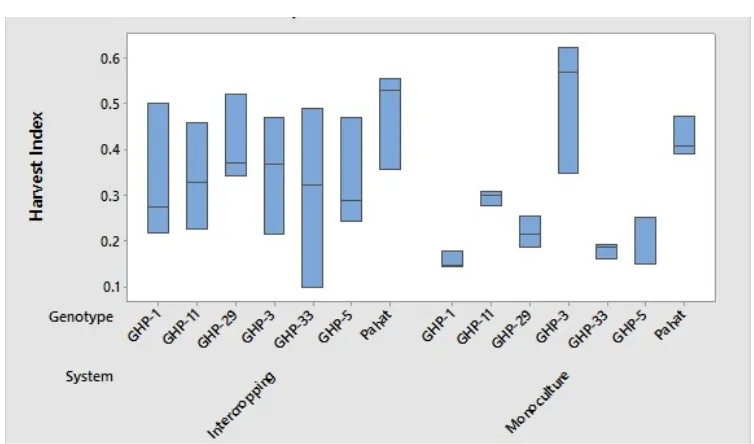INTERCROPPING WITH CASSAVA
Muhammad Syamsoel Hadi1,2), Muhammad Kamal2), Erwin Yuliadi3), F. X.
Susilo4), and Kukuh Setiawan2)
1) Doctoral Program in Agricultural Science , College of Agriculture, University
of Lampung - Indonesia
2) Department of Agronomy and Horticulture, College of Agriculture, University
of Lampung – Indonesia
3) Department of Agrotechnology, College of Agriculture, University of
Lampung - Indonesia
4) Department of Plant Protection, College of Agriculture, University of Lampung
– Indonesia
Abstract
This experiment aims to determine the agronomic characteristics of some grain sorghum [Sorghum bicolor (L.) Moench] genotypes under intercropping with cassava. The experiment was conducted in Gadingrejo, Pringsewu Regency from April 2015 to September 2015. The experiment was arranged in a Split-Plot Randomized Complete Block Design with three replications, in which cropping systems (sorghum monoculture and sorghum-cassava intercropping) as the main plots and 7 sorghum genotypes (1, 3, 5, 11, 29, GHP-33, and Pahat) as subplots. Our results showed that the highest grain weight per plant (51.1 g) was achieved by promising line GHP-3 when planted as monoculture. It was supported by its highest harvest index (HI) (0.58) compared to the other genotypes. On the other hand, grain weight per plant of GHP-3 was declined when planted under intercropping (33.6 g with HI = 0.39). Although variety Pahat had lower grain weight per plant than GHP-3, our result showed that Pahat did not significantly decrease under intercropping with cassava.
Keywords: cassava, intercropping, sorghum Introduction
The sorghum plant has become the fourth-largest grain crop in the world, and occupies the fifth position in terms of planting area, after wheat, rice, corn, and barley. Even this plant is a staple food in semi-arid tropical regions (Rao P. et al., 2014). In addition to being reliable as food crops, sorghum can also be used as animal feed and supply of industrial raw materials, such as syrup. In Asia sorghum is grown mostly in South Asia (Reddy and Patil, 2015). In the southeastern part of the United States, in addition to cattle feed, even sorghum has long been a tradition as a syrup and sugar-producing plant (Teetor et al., 2011).
stress (Ibrahim et al., 2013). For high production, moderate to long sorghum cultivars (reaching maturity within 110-130 days) require about 450-650 mm of water during the growing season (Assefa et al., 2010). This requirement of water requirement is very suitable for cultivating the sorghum on dry land in the season where rainfall has begun to decrease a lot, such as before dry season where the land is usually not cultivated.
In Indonesia, sorghum has the potential to be developed in dry and rain-fed areas of up to 52.5 million ha (Aqil and Bunyamin Z., 2013). However, the sorghum plant has not been widely known in the Lampung area, and it is even difficult to obtain official data on the extent of this cultivation. The area of this plant in Lampung is still very limited, and there are only about 25 ha in Lampung Selatan (Subagio and Aqil, 2013). Meanwhile, considering irrigated wetland area (often not exploited during dry season) in Lampung there are 174,668 ha, tegal / garden 743,725 ha, and field / huma 289,549 ha (Center of Data and Information System of Agriculture, 2014). By considering the large dry land area, Lampung is a potential area for the development of sorghum plants.
Due to the limited land, planting sorghum in monoculture system is constrained by the use competition with other important crops such as palm oil, sugarcane, rubber plant, cassava, etc. In Lampung, cassava planting area is around 300,000 ha. There is a possibility to plant sorghum under intercropping with cassava. However, the main problem is the effect of sorghum growth which might be influenced by cassava canopy. Shade condition in general could affect the growth and yield of sorghum. Evaluation of agronomic characteristics of some sorghum genotypes will be useful in contributing to plant breeders in order to develop high-yield genotypes in terms of both biomass and seed yield. Several genotypes of sorghum have the ability to produce seeds, forage, or both. This study aims to evaluate the agronomic characteristics appearance of several genotypes of sorghum under intercropping with cassava.
Materials and Methods
(100 kg/ha). Three samples were taken per plot. Sorghum was harvested when the seeds already reached physiological stage.
Results and Discussions
In general, there is no significant difference between intercropping and monoculture system for stem dry weight. Genotypes of GHP-5, GHP-11, GHP-29, and Pahat had lower stem dry weight when planted as intercropping with cassava than monoculture (Figure 1). Meanwhile, for the leaf dry weight only Pahat underwent the decrease when intercropped with cassava (Figure 2).
The differences of the above values do not affect the grain weight of each genotype (Figure 3).
Figure 2. Leaf weight per plant of some sorghum genotypes under intercropping with cassava.
Figure 4. 100-grains weight of some sorghum genotypes under intercropping with cassava.
In intercropping with cassava, GHP-29 had higher grain number compare to monoculture (Figure 5). It supported the fact that the GHP-29 had higher harvest index value when planted in intercropping (Figure 6). In contrast, GHP-3 underwent decrease grain number when planted as monoculture (Figure 5).
Figure 6. Harvest Index of some sorghum genotypes under intercropping with cassava.
Conclusions
Planting sorghum intercropped with cassava, in general is potential to develop sorghum plantation in cassava plantation areas. It was proved by the no significant difference in almost all variables observed. In addition, GHP-29 even indicated its better potential when planted as intercropping with cassava.
References
Assefa, Y., S.A. Staggenborg, and V.P.V. Prasad. 2010. Grain Sorghum Water Requirement and Responses to Drought Stress: A Review. Crop Management 9(1). Digital Library. DOI: 10.1094/CM-2010-1109-01-RV.
Aqil, M. dan Bunyamin Z. 2013. Optimalisasi Pengelolaan Agroklimat Pertanaman Sorgum. Seminar Nasional Serealia, 2013. Hlm: 398 – 406. ISBN: 978-979-8940-37-8.
Ibrahim A.H., El-Shahaby O.A., Abo-Hamed S.A., and Younis M.E. 2013. Parental drought and defoliation effect on yield, grains biochemical aspects and drought performance of sorghum progeny. J. Stress Physiol. & Biochem. 9(1): 258-272.
Rao P., S., B.V.S Reddy, N. Nagaraj, and H.D. Upadhyaya. 2014. Sorghum production for diversified uses. In: Genetics, Genomics and Breeding of Sorghum (Eds: Yi-Hong Wang, Upadhyaya, H.D, and C. Kole). CRC Press. Boca Raton, FL 33487-2742. 344p.
Subagio, H. dan M. Aqil. 2013. Pengembangan Produksi Sorgum di Indonesia. Seminar Nasional Inovasi Teknologi Pertanian, 2013. Hal: 199 – 214. Teetor, V.H., D.V. Duclos, E.T. Wittenberg, K.M. Young, J. Chawhuaymak,



